|
In the historical district of Tondabayashi Jinaimachi, there remain as
many as forty old wooden-structured merchants' houses built during the
Edo period (the 17th - Mid. 19th centuries) and thenafter, as the whole
town looks like a movie location site and you can enjoy a time-slipping
journey here. The town area was designated as an important historical district
and heritage site of Japan. |
|
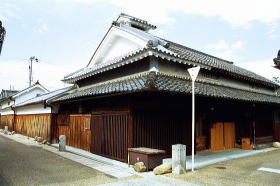 |
Residence of (east)Okutani family (Not open to the public. 非公開) Mr. Iroku Okutani, the founder, started to run the family business of a rape-seed oil trading and distribution. Iroku is the son of Iemon, the successor (the 2nd generation) of the main Okutani family which had run the timber trading business under the trading name of Iwase-ya. The main building is characterized by a small overtopped roof for smoke ventilation, the design of which is incorporated into the souvenir cookies. In between the two residences of the main Okutani's and east Okutani's, there is a small moat in 1.5 meters depth for fire-fighting and sewarage purpose and is the small stone bridge called Gan-ei Hashi alongside Jonomonsuji Street. |
| Jonomonsuji (monument) - one of the 100 roads of Japan Jonomonsuji passes through the historical district from north to south. The 300-meter' main street was designated as one of the 100 roads of Japan in 1986 in commemoration of "The road day". In Osaka pref., Midousuji Street (Osaka city) and Phoenix Street (Sakai city) have been also nominated as the 100 roads of Japan. |
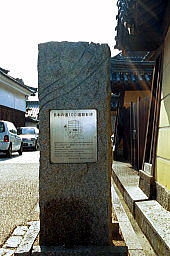 |
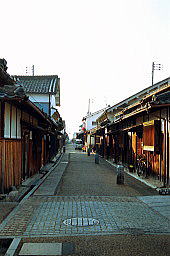 |
Jonomonsuji Street Alongside the street, there line up Koshouji Betsuin Temple, traders' or "sake" brewers' old town houses with slatted lattices and storehouses with white mortar walls. The name of the street was derived from the main gate of Koshoji Betsuin temple which had been moved from one of the castle gates in Momoyama castles, built in Kyoto by Toyotomi Hideyoshi, a famous warlord. in the 16th century. "Jonomon" means "a gate of a castle" in Japanese. |
| Atemage-no-michi The roads called "Atemage-no-michi" mean those roads whcih do not intersect at right angles at each cross road in Jinaimachi town. This could make it diffucult for strangers to look throughout the street. These are reminants of devices to avoid being involved in the battles between feudal warlords in the 16th century. |
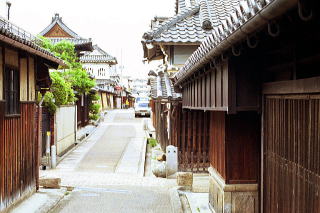 |
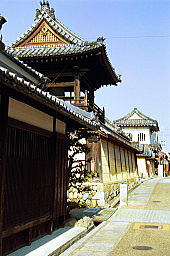 |
Koshouji Betsuin Temple (Tondabayashi Gobo) Koshoji Betsuin Temple, belonging to the Jodoshinshuu sect of Buddhism, took the initiative to newly develop the Jinaimachi town. The temple is often called "Gobo-san" by the local residents. Jinaimachi district prospered as the center of trade and distribution in the southern part of Kawachi region. The drum tower of Koshoji temple is characterized by a bell-shaped window ("Kato-mado") , the design of which is incorporated into the souvenir cookies. |
Three-storied storehouse of (south) Kuzuhara"s residence (Not open to the public. 非公開) The three-storied storehouse can be rarely seen in Japan and might be called as the landmark of Jinaimachi town. The storehouse was used to store rice crop of farm rent. The storehouse is characterized by its proportional beauty and a contrast of colors , the design of which is incorporated into the souvenir cookies. |
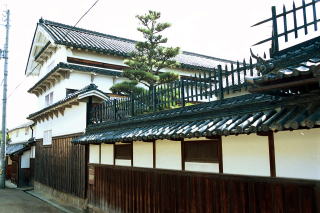 |
| Jinaimachi sembei are egg-flavoured cookies featuring the characteristic designs from the landscape in the town, such as an old temple and town houses.. The cookies are baked exclusively at the confectionary shop of "Kashiwaya- Katsuragido" near the Tondabayashi station. The shop is famous for its 140 years long-standing and variety of Japanese style confectionary. A small leaflet briefing the history on Jinaimachi is also complimentarily provided. |
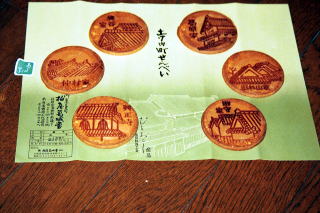 |
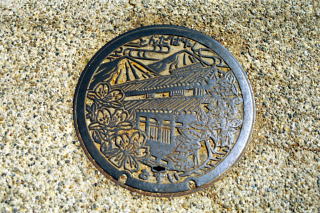 |
A decorative design of manhole cover As a part of landscaping, utility poles were moved backward to the inconspicuous position. The manhole covers have such designs as the landscape of Jinaimachi and Kongo Mountains. The decorative manhole covers can be seen everywhere in the city. Would you "watch your steps" in the Jinaimachi town for a short while? |
| Former residence of Sugiyama family - an important cultural property of the Nation (Open to the public、公開) The Sugiyama Family is said to have settled in Jinaimachi at the very beginning
of the town. As a brewer, this family played a leading role in the “sake”
brewing industry of Kawachi region from the Edo period to the middle of
Meiji era. It is said that as many as 70 employees worked there in its prime. |
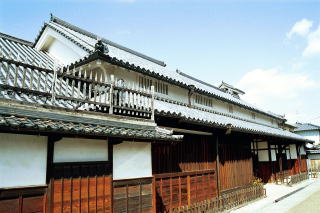 |
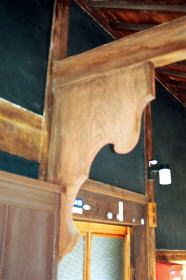 |
Jinaimachi Center (Open to the public) The center is located at the opposite of the former residence of Sugiyama family. Some old maps, including "Kawachi Meishozue" and old tools and furnitures are displayed in the center. Rest room facillty for visitors is available here. |
| Rock-made water tank for fire-fighting - beside the entrance of residence of (main) Okutani family The Chinese ideograph "水" (water) is engraved on the surface of the stone vessel. We may come across the residents' great consciousness and morality to prevent the town from fire. That's the main reason why the invaluable heritage still remains as used to be, fortunately free from a big fire and a disaster. |
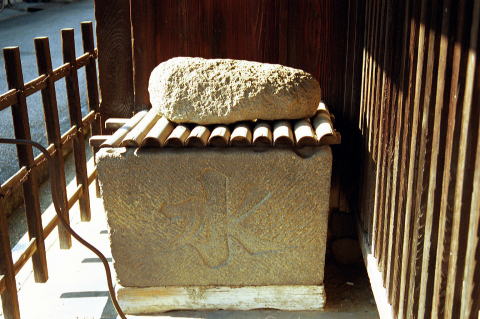 |
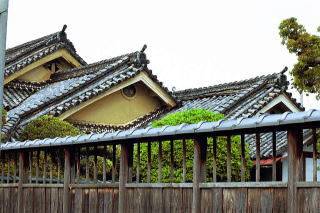 |
Residence of Nakamura family (Not open to the public, 非公開) The family had run a "sake" brewery. According to the old records, well-known men of letters, Mr. Shoin Yoshida and Mr. Sanyo Rai had ever visited the residence. The residence has been designated as a tangible cultural asset of Osaka prefecture. The residence of Nakamura family is characterized by the three-layered roofs. the design of which is incorporated into the souvenir cookies. |
| Rock barriers The area of Jinaimachi town which used to be a barren land called “Tonda-no-Shiba”, a river terrace where you can overlook the Ishikawa River and Kongo Mountains. The 14th Saint Shoshu purchased this area from the governor of Kawachi region and founded an branch of Koshoji temple with the help of the leaders and believers of the neighboring 4 villages. Then this area developed into a temple-town with four gates, where self-government and self-defense could be seen, such as the rock barriers.bamboo groves and moats There still remain some remnants now. |
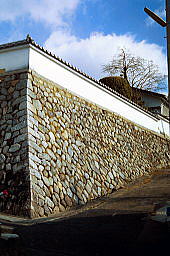 |
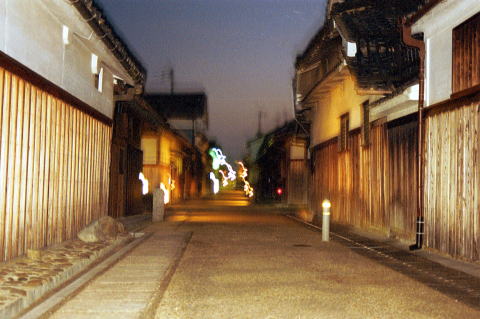 |
Lighting up the Jinaimachi Lighting stuffs alongside the stone-paved Jonomonsuji Street - one of the 100 roads of Japan help light-up the historical district and heritage site. |
| Shinobi-gaeshi (Wooden fence on top of the wall) |
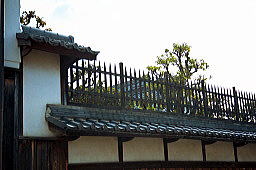 |
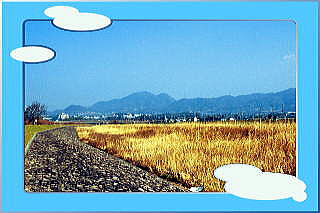 |
Riverbed of the Ishikawa River Many red-colored dragonflies appear along the dry riverbed in Autumn. The shuttle service of river boats used to contribute the prosperity of Jinaimachi in transporting merchandise goods The Minami-Kawachi region is characterized by its myth, old history and a lot of ancient heritage, including ancient tombs, the oldest national route from Osaka to Nara, an old capital. ("Takenouchi-Kaido") and old temples in the medieval times. |
| Tomi-Ebisu Shrine "Ebisu" is a Shinto diety of commerce and also a tutelary diety of the town, which has been watching over the prosperity of Jinaimachi town for a long time. The diety has been worshipped at the Tomi-Ebisu shrine and is often called "Ebessan" by the local residents. The annual festival in honor of Ebisu is held during 9-11th, January. |
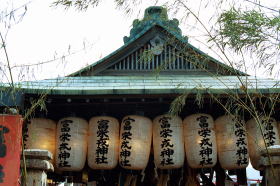 |

